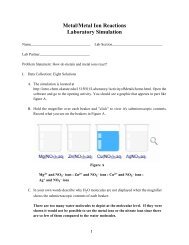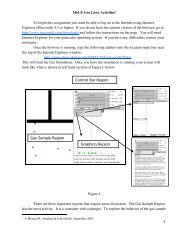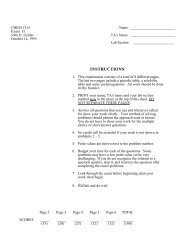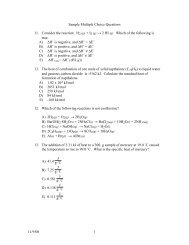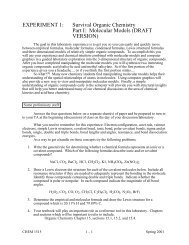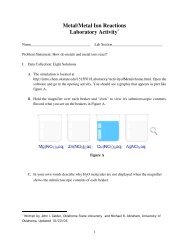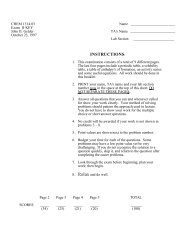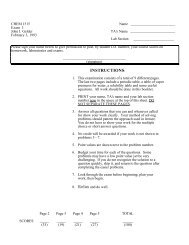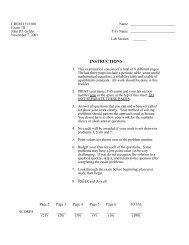final exam
final exam
final exam
Create successful ePaper yourself
Turn your PDF publications into a flip-book with our unique Google optimized e-Paper software.
Chemistry 1215Section #2Exam IV and FinalJohn I. GelderMay 4, 1988Name ________________________Section ___________TA's Name ____________________INSTRUCTIONS:1. This <strong>exam</strong>ination consists of a total of 10different pages. The problems (1 – 11) on pages2 – 5 make–up the 4th <strong>exam</strong>, while the problems(12 – 23) on pages 6 – 8 are the <strong>final</strong> <strong>exam</strong>. Thelast two pages includes useful information and aperiodic table. All work should be done in thisbooklet.2. PRINT your name, section number and T.A.'sname now in the space at the top of this sheet.DO NOT SEPARATE THE PAGES .3. Answer all questions that you can and whenevercalled for show your work clearly. Theapproach used to solve stoichiometry problemsmust pattern the approach used in lecture.4. Show your work on Problems 3, 4, 9 – 12, 20,22 and 23.5. Point values are shown next to the problemnumber.6. Budget your time for each of the questions.Some problems may have a low point value yetbe very challenging. If you do not recognize thesolution to a question quickly, skip it, and returnto the question after completing the easierproblems.7. Look through the <strong>exam</strong> before beginning; planyour work; then begin.8. Relax and do well.4thFINALPage 2 Page 3 Page 4 Page 5 TOTAL Page 6 Page 7 Page 8 TOTALSCORES _____ _____ _____ _____ _____ _____ _____ _____ ______(20) (14) (8) (8) (50) (28) (25) (22) (75)
CHEM 1215 EXAM IV & FINAL PAGE 2(8) 1. Complete and balance the following reactions. Using the Solubility Table, identify whether each productis soluble (aq) or insoluble (s).a) Na 2 CO 3 (aq) + Pb(NO 3 ) 2 (aq) →b) K 2 S(aq) + Pb(NO 3 ) 2 (aq) →c) Na 3 PO 4 (aq) + Ba(NO 3 ) 2 (aq) →d) NH 4 NO 3 (aq) + FeCl 3 (aq) →(2) 2. Complete and balance the following equations. (If no reaction occurs write NR.)a) BaO(s) + H 2 O(l) →b) SO 3 (g) + H 2 O(l) →(5) 3. Calculate the volume occupied by 16.0 g of CO 2 gas at 720 mmHg and –20 ˚C.(5) 4. If a vessel with 1.38 mol of an ideal gas has a pressure of 400 mmHg, calculate the new pressure if thenumber of moles of the gas is increased to 2.16 mol. (Assume the volume and temperature areconstant.)
CHEM 1215 EXAM IV & FINAL PAGE 3(4) 5. Discuss hydrogen–bonding in water. (In your discussion include; the definition of hydrogen–bonding,a diagram of at least three water molecules and how they hydrogen–bond to each other {clearly label thehydrogen–bonds}, how hydrogen–bonding effects the boiling point of water and the density of solidand liquid water.)(6) 6. Define vapor pressure for a liquid. Also explain, how the vapor pressure of a liquid depends ontemperature, and define the boiling point of a liquid.(4) 7. Briefly describe what happens when a small amount of NaCl is added to water. (In your discussioninclude; whether NaCl dissolves or not, a chemical equation for the solution process and a simple pictureof what sodium chloride looks like dissolved in water at the atomic level .)
CHEM 1215 EXAM IV & FINAL PAGE 4(4) 8. What volume of a 0.450 M HCl solution contains 3.75 moles of HCl?(4) 9. Briefly describe how you would prepare 500 mL of a 0.800 M NaCl solution starting with a NaClsolution which is 2.50 M.
CHEM 1215 EXAM IV & FINAL PAGE 5(4) 10. Calculate the weight percent and the molality of a solution prepared by adding 20.0 g of glucose(C 6 H 12 O 6 ) to 430 g of water.(4) 11. Calculate the freezing point and the boiling point of the solution in Problem #10.
CHEM 1215 EXAM IV & FINAL PAGE 6(6) 12. My office is 5.25 meters long, 4.85 meters wide and 2.75 meter high. If the density of air at roomtemperature is 1.19 g/L, calculate the mass of the air in my office.(6) 13. Solve the following mathematical problems and state the answer to the correct number of significantfigures. (Note: the numerical answer must be correct for credit.)a) 302.4579 g b) 296.05.24–56.63 g= c)(37.92 – 29.823) * 10.0284.235 =(8) 14. Complete the following table.Substance Formula Physical PropertiesSodiumHydrogenLead IodideSodium hydroxide(2) 15. For one of the substances in Problem #14, briefly describe a chemical property as seen in lecture orlaboratory.(6) 16. Write the ground state electron configuration for the following species.a) Mgb) Cuc) Pb
CHEM 1215 EXAM IV & FINAL PAGE 7(6) 17. Complete the following table by inserting the name of a compound or a formula:Compound NameFormula______________________________ FeCl 3dinitrogen tetroxide______________________________________________ H 3 PO 4aluminum hydroxide______________________________________________ NH 4 NO 3barium phosphate________________(7) 18. Determine the oxidation state for each element in the following compoundsa) NaH 2 PO 4 Na __________ H __________ P __________ O __________b) K 2 Cr 2 O 7 K __________ Cr __________ O __________(6) 19. Draw the Lewis electron dot structure for the following moleculesa) ClO 3–b) CF 4(6) 20. Trinitrotoluene (TNT) is 37.0 % carbon, 2.22 % hydrogen, 42.3 % oxygen and 18.5 % nitrogen.Determine the empirical formula for TNT.
CHEM 1215 EXAM IV & FINAL PAGE 8(7) 21. Complete the following tableFormulaMolar Mass of Moles of Number of atoms,Mass⎛ g ⎞⎝ mol ⎠Sample (g) Sample (mol) molecules, or formula unitsC 6 H 12 O 6 14.75AlCl 3 133.5 4.302 x 10 21 formula unitsunknown 20.3 0.0916(7) 22. How many grams of I 2 are produced by the reaction of 0.360 moles of CuCl 2 with excess KI?CuCl 2 (s) + KI(s) → CuI(s) + KCl(s) + I 2 (s)(8) 23. Calculate the mass of carbon dioxide produced when 10.0 grams of propane (C 3 H 8 ), is burned in 25.0grams of oxygen? (Hint: This is a combustion reaction.)
CHEM 1215 EXAM IV & FINAL PAGE 9Useful InformationR = 0.0821 atm. Lmol . KPV=nRTAvogadro's Number = 6.02 x 10 23 ∆T = mk k f (H 2 O) = 1.86 ˚C m : k b(H 2 O) = 0.52 ˚C m(˚F – 32)1.8 = ˚C1 inch (in) = 2.54 centimeters (cm) 1 pound (lb) = 454 grams (g)1.057 quarts = 1 liter (L)Activity SeriesMetals: K, Ca, Na, Mg. Al, Zn, Fe, Sn, Pb, H, Cu, Ag, Hg, AuHalogens: F 2 , Cl 2 , Br 2 , I 2Class Solubility in cold waterNitrates All nitrates are soluble.Acetates All acetates are soluble.Chlorides, All chlorides, bromides, and iodides are soluble except those of Ag, Hg(I),Bromides, and Pb(II); PbCl 2 and PbBr 2 are slightly soluble in hot water.IodidesSulfates All sulfates are soluble except those of Ba, Sr, and Pb; Ca and Ag sulfates are slightlysoluble.Carbonates, All carbonates and phosphates are insoluble except those of Na, K, and NH 4 .Phosphates Many bicarbonates and acid phosphates are soluble.Hydroxides All hydroxides are insoluble except those of the alkali metals and NH 4 OH; Ba(OH) 2 andCa(OH) 2 are slightly soluble.Sodium saltsPotassium salts All common salts of these ions are soluble.Ammonium saltsSulfides All sulfides are insoluble except those of the alkali metals, ammonium, and the alkaline earthmetals (Ca, Mg, Ba).
CHEM 1215 EXAM IV & FINAL PAGE 101234567IA1H1.0083Li6.9411IIA4Be9.0112Na Mg22.99 24.3019 20KCa39.10 40.0837Rb Sr3885.47 87.6255 56CsBa132.9 137.387 88Fr(223)Ra226.0IIIA IVA VA VIA VIIA 4.005 6 7 8B C N O F9 10Ne10.81 12.01 14.01 16.00 19.00 20.1813 14 15 16 17 18IIIB IVB VB VIB VIIB VIII IB IIB 26.98 28.09 30.97 32.06 35.45 39.9521 22 23 24 25 26 27 28 29Sc Ti V Cr Mn Fe Co Ni Cu 30 31 32 33 34 35 36Zn Ga Ge As Se Br Kr44.96 47.88 50.94 52.00 54.94 55.85 58.93 58.69 63.55 65.38 69.72 72.59 74.92 78.96 79.90 83.8039Y Zr40 41 42 43 44 45 46 47 48 49 50 51 52 53 54Nb Mo Tc Ru Rh Pd Ag Cd In Sn Sb Te I Xe88.91 91.22 92.91 95.94 (98) 101.1 102.9 106.4 107.9 112.4 114.8 118.7 121.8 127.6 126.9 131.357 72 73 74 76 77 78 79 81 82 83 84 85 86LaPeriodic Table of the ElementsHfAlSiPSClVIIIA2Ta W Re 75Os Ir Pt Au Hg 80Tl Pb Bi Po At Rn138.9 178.5 180.9 183.8 186.2 190.2 192.2 195.1 197.0 200.6 204.4 207.2 209.0 (209) (210)89 104 105 106 107 108 109Ac227.0Rf DbSgBhHs Mt(261) (262) (263) (262) (265) (266)HeAr(222)LanthanidesActinides58 59 60 61 62 63 64Ce Pr Nd Pm Sm Eu Gd 65 66 67 68 69 70 71Tb Dy Ho Er Tm Yb Lu140.1 140.9 144.2 (145) 150.4 152.0 157.2 158.9 162.5 164.9 167.3 168.9 173.0 175.090 91 92 93 94 95 96Th Pa U Np Pu AmCm 97 98 99 100 101 102 103Bk Cf Es Fm Md No Lr232.0 231.0 238.0 237.0 (244) (243) (247) (247) (251) (252) (257) (258) (259) (260)




